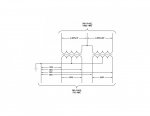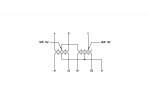You are using an out of date browser. It may not display this or other websites correctly.
You should upgrade or use an alternative browser.
You should upgrade or use an alternative browser.
Two phase power
- Thread starter domnic
- Start date
- Status
- Not open for further replies.
- Location
- Massachusetts
In early days of power plants did any of them put out two phase power?
Yes, and some remain
https://en.wikipedia.org/wiki/Two-phase_electric_power
Bugman1400
Senior Member
- Location
- Charlotte, NC
I've been in hundreds of power plants (some dating from the teens) and have never personally seen that. I would expect those units to be small and probably driven by a small dam or diesel engine. Would be cool to see though!
zbang
Senior Member
- Location
- Roughly 5346 miles from Earls Court
IIRC about the only place you'll still see real two-phase power is parts of Center City Philadelphia, and even then the PoCo uses a Scott-T transformer to make it. And from reports, they won't change the services to real three-phase unless the customer pays. (Been a couple of threads on these forums about it.)
- Location
- Placerville, CA, USA
- Occupation
- Retired PV System Designer
An interesting side note in that article is that a two-phase service with no center taps required either four wires or three wires with the common larger than either phase conductor. (common current = phase current times sqrt(2)).
So a three phase delta, once the principles were understood well enough to make it useful, required fewer conductors than two phase.
- Location
- San Francisco Bay Area, CA, USA
- Occupation
- Electrical Engineer
The original Tesla /Westinghouse system first installed in Niagara that launched AC as the dominant distribution system was 2 phase. There are, last I heard, still a few 2 phase installations around that area and pockets in northern New York State as well.
Ah, just read that wiki, it says that in there too.
Ah, just read that wiki, it says that in there too.
big john
Senior Member
- Location
- Portland, ME
I don't know of any utility provided 2Ø but we have a number of customers that were converting it locally because of a massive number ofexisting original 2Ø motors. Up until recently we even had a customer running 2Ø 40Hz for their primary distribution. Now that was a weird animal to work on.IIRC about the only place you'll still see real two-phase power is parts of Center City Philadelphia, and even then the PoCo uses a Scott-T transformer to make it. And from reports, they won't change the services to real three-phase unless the customer pays. (Been a couple of threads on these forums about it.)
zbang
Senior Member
- Location
- Roughly 5346 miles from Earls Court
Up until recently we even had a customer running 2Ø 40Hz for their primary distribution. Now that was a weird animal to work on.
A mill with it's own generation? Do tell.
At last check PeCo still has 2-ph customers, it's still on their service order form and in their Blue Book ("2 phase 5 wire 120/240v minimum 7.5hp polyphase load").
A mill with it's own generation? Do tell.
At last check PeCo still has 2-ph customers, it's still on their service order form and in their Blue Book ("2 phase 5 wire 120/240v minimum 7.5hp polyphase load").
When I sold transformers whenever I received an RFQ for a 3ph to 2ph transformer I always asked if they needed a 4 wire or 5 wire secondary because quite often they either didn't check or didn't have a clue as the quote often is used for order entry. Building a transformer correctly prevents a lot of grief later.
JoeStillman
Senior Member
- Location
- West Chester, PA
- Occupation
- Electrical PE
A mill with it's own generation? Do tell.
At last check PeCo still has 2-ph customers, it's still on their service order form and in their Blue Book ("2 phase 5 wire 120/240v minimum 7.5hp polyphase load").
The old "PD" rate was 4,160V, 2Ø, 3-wire. Some medium-size buildings still have it, but every one of them has a 13.2 kV Scott-connected transformer somewhere upstream. There is still a market for phase changers.
kwired
Electron manager
- Location
- NE Nebraska
- Occupation
- EC
You would think POCO would want to get rid of the somewhat non standard equipment to have to maintain. I can still see the customer having to pay to upgrade but maybe some break from the POCO to give enough incentive to encourage doing such upgrade.IIRC about the only place you'll still see real two-phase power is parts of Center City Philadelphia, and even then the PoCo uses a Scott-T transformer to make it. And from reports, they won't change the services to real three-phase unless the customer pays. (Been a couple of threads on these forums about it.)
- Location
- San Francisco Bay Area, CA, USA
- Occupation
- Electrical Engineer
You would think POCO would want to get rid of the somewhat non standard equipment to have to maintain. I can still see the customer having to pay to upgrade but maybe some break from the POCO to give enough incentive to encourage doing such upgrade.
I once spoke with someone from that area who said the local power company in Philly did incentivize people to change way back when. But some of the old furniture factories there who were using the original 2 phase power now have historical landmark status and they want everything preserved as it has been. The utility no longer generates 2 phase, nor do they allow new hookups, they just adapt the standard 3 phase distribution for those grandfathered installations by using Scott-Tee transformers at their service drop.
Next time I'm in that area I plan on finding somewhere to visit and tour to see that. I love old historical electrical installations. I had a farmer friend down the road who's father was the first person to install electricity in this area for his walnut harvesting machinery, all hand built. He has one large repulsion-induction motor feeding a system of leather belts and pulleys in the rafters powering everything. I helped him rebuild the motor and the 1930s vintage motor starter for it. I never took pictures unfortunately because that was pre-cell phone. He passed away right after we got it all working again, willing his farm to the city, who wants to tear it down to build a hotel. We are fighting it tooth and nail, but the site is locked up behind a chain link fence so I no longer have access to his barn. If I ever get it, I'm taking pictures for sure.
kwired
Electron manager
- Location
- NE Nebraska
- Occupation
- EC
I once spoke with someone from that area who said the local power company in Philly did incentivize people to change way back when. But some of the old furniture factories there who were using the original 2 phase power now have historical landmark status and they want everything preserved as it has been. The utility no longer generates 2 phase, nor do they allow new hookups, they just adapt the standard 3 phase distribution for those grandfathered installations by using Scott-Tee transformers at their service drop.
Next time I'm in that area I plan on finding somewhere to visit and tour to see that. I love old historical electrical installations. I had a farmer friend down the road who's father was the first person to install electricity in this area for his walnut harvesting machinery, all hand built. He has one large repulsion-induction motor feeding a system of leather belts and pulleys in the rafters powering everything. I helped him rebuild the motor and the 1930s vintage motor starter for it. I never took pictures unfortunately because that was pre-cell phone. He passed away right after we got it all working again, willing his farm to the city, who wants to tear it down to build a hotel. We are fighting it tooth and nail, but the site is locked up behind a chain link fence so I no longer have access to his barn. If I ever get it, I'm taking pictures for sure.
I can see POCO leaving existing equipment as is, by choice, some would ultimately turn and say the Scott-T belongs to customer and customer will be responsible for maintenance/replacement of it if needed.
Sort of no different then if you wanted some odd voltage/frequency/number of phases/DC/ even three phase where only single phase is all that is readily available - customer has to find their own method of deriving those systems.
Bugman1400
Senior Member
- Location
- Charlotte, NC
I once spoke with someone from that area who said the local power company in Philly did incentivize people to change way back when. But some of the old furniture factories there who were using the original 2 phase power now have historical landmark status and they want everything preserved as it has been. The utility no longer generates 2 phase, nor do they allow new hookups, they just adapt the standard 3 phase distribution for those grandfathered installations by using Scott-Tee transformers at their service drop.
Next time I'm in that area I plan on finding somewhere to visit and tour to see that. I love old historical electrical installations. I had a farmer friend down the road who's father was the first person to install electricity in this area for his walnut harvesting machinery, all hand built. He has one large repulsion-induction motor feeding a system of leather belts and pulleys in the rafters powering everything. I helped him rebuild the motor and the 1930s vintage motor starter for it. I never took pictures unfortunately because that was pre-cell phone. He passed away right after we got it all working again, willing his farm to the city, who wants to tear it down to build a hotel. We are fighting it tooth and nail, but the site is locked up behind a chain link fence so I no longer have access to his barn. If I ever get it, I'm taking pictures for sure.
Please take some hi-res pics. I also love old elec installs.
JoeStillman
Senior Member
- Location
- West Chester, PA
- Occupation
- Electrical PE
I was recently commissioned to survey an old factory in North Philly where the old 2300V, 2Ø service had been upgraded to 13.2 kV, 3Ø. The customer owned his own primary distribution so there was access to the old equipment. Here are some pictures I took with my phone. (Don't worry, it was all de-energized.)
This is the 13.2 kV to 2300 V phase changer in a vault with a bunch of other dead oil pots.
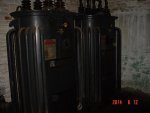
Here's a vault with the two banks of old 2300V to 120/240V 2Ø oil-filled transformers. Note the 3-pole oil switches on the primaries. Don't be fooled! it really was 2Ø.
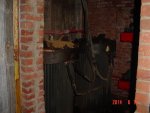
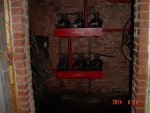
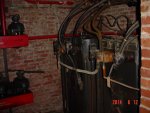
On the load side of these old pots was a bunch of 4-pole switches like these. (I-T-E was quite popular in Philly, back in the day!)
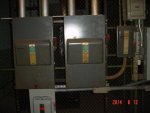
This is the 13.2 kV to 2300 V phase changer in a vault with a bunch of other dead oil pots.

Here's a vault with the two banks of old 2300V to 120/240V 2Ø oil-filled transformers. Note the 3-pole oil switches on the primaries. Don't be fooled! it really was 2Ø.



On the load side of these old pots was a bunch of 4-pole switches like these. (I-T-E was quite popular in Philly, back in the day!)

JoeStillman
Senior Member
- Location
- West Chester, PA
- Occupation
- Electrical PE
You would think POCO would want to get rid of the somewhat non standard equipment to have to maintain. I can still see the customer having to pay to upgrade but maybe some break from the POCO to give enough incentive to encourage doing such upgrade.
They can't make the customers change out the old 2Ø, 5W lighting panels (even though the customer really should!). Peco jumps at the chance to get rid of old phase changers though, whenever someone applies for new service.
JoeStillman
Senior Member
- Location
- West Chester, PA
- Occupation
- Electrical PE
JoeStillman
Senior Member
- Location
- West Chester, PA
- Occupation
- Electrical PE
ptonsparky
Tom
- Occupation
- EC - retired
I just had a local "wheeler dealer" ask me about a 2 phase mill he bought at a good price. Maybe 30 minutes ago. I had to keep from grinning to much as he asked me about it.
He has single phase but the transformer connection above is interesting.
- Location
- Placerville, CA, USA
- Occupation
- Retired PV System Designer
Are there 2 phase VFDs available? 
- Status
- Not open for further replies.

